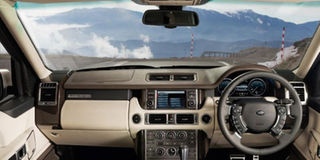Review of the later 3rd generation Range Rover

Range Rover is a flagship of the Land Rover built by the British over four generations as a four wheel drive sports utility vehicle (SUV).
The first generation was the Classic model built between 1970 and 1996 while the second generation (Range Rover P38) arrived between 1994 and 2002.
The third generation Range Rover Vogue (2002-2012) also called 2010 L322 was designed and rolled out by BMW before it was taken over by Ford.
The fourth generation (2012-2017) arrived later after Tata had taken over the reins at Land Rover.
Range Rover is revered for its iconic go anywhere prowess and is envied as a bench mark of ultimate SUV luxury.
It has for long been the trophy of royals, statesmen and successful private citizens.
Design cues
A look at the 2010 L322 (third generation) reveals how much Range Rover has changed looks over the decades.
The third generation model sheds off the utilitarian Spartan looks of the 1970s and 80s introducing sharp edges mounted on a chassis frame like a typical Land Rover workhorse.
The third generation Range Rover is rounder, longer and more aerodynamic and has an embed the frame in a mono-coque body.
It was BMW’s improvement of the 2nd generation, which has softer flat panels, looks trimmer and more corporate.
It is also the later edition under the tutelage of Ford; with some design updates which make it look better than the first edition.
The chrome sports front grille and side ‘shark’ fins, flat edge round bumper, smart steering activated Bi xenon head lamps and LED tail lamps give the third generation a bolder and sharper look.
Comfort and interior
The interior reveals the luxury and opulence of a ‘palace on wheels’.
The five occupants are treated to soft, comfortable but supportive rich ivory leather upholstery with the supple leather finish generously covering the upright high command seats, doors, dashboard and headliner.
The centre console is designed with chrome spurts and air vents stacked with precision between natural looking walnut wood trim.
A multimedia screen provides infotainment and can show wheel articulation or position during off road driving.
This is a far cry from Classic’s plasticky hard interior with fabric seats. The interior is spacious enough and the trunk offers enough load space.
Handling and performance
Range Rover Vogue feels nimble and responsive to throttle. The 2010 3.6 litre Ford Duratorq Turbo diesel V8 engine under the hood was designed to thrill.
The 3.6 litre TDV8 is not a leaping Jaguar like the 5.0 litre V8 petrol. Besides delivering excellent fuel economy, the engine has subdued clutter and instant power response.
In a ride on Kayunga road I get an uninterrupted feel and I don’t waste time to put on the 270 horse driven carriage.
It effortlessly navigates sharp bends as the air suspension, electronic all terrain control and stability programmes combine to keep it stable.
Safety, reliability and maintenance
The safety features include frontal, sideways and lumbar airbag protection, electronic brake distribution and stability programmes.
Most importantly the car feels heavy on and off the road and the air suspension dampens any road imperfections.
The third generation Range Rover is reliable if bought with a good service history and mileage below 100,000 kilometres.
Poor maintenance or high mileage comes with a huge repair bill.
There are no short cuts in the maintenance curve as they attract a heavy price. The local Land Rover dealer and independent parts suppliers will keep you on the road when you need to maintain this car but at a pricy premium.
But hey, who said good things don’t come at a price?




